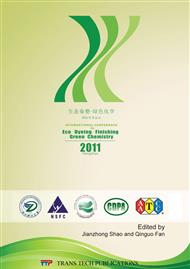p.57
p.61
p.66
p.72
p.78
p.83
p.88
p.92
p.96
The Process of Silk Fabric Printed with Mulberry Red
Abstract:
The process of silk fabric printed with a natural dye such as mulberry red has been studied. Sodium alginate could meet the need of silk printing. The optimum printing condition was that, steaming temperature was 100 °C, for 20 min with saturated steam. When the dye concentration relative to original paste reached 4%, the maximum of color depth could be achieved. The printed silk fabric with different mordants can get different colors.
Info:
Periodical:
Pages:
78-82
Citation:
Online since:
January 2012
Authors:
Keywords:
Price:
Сopyright:
© 2012 Trans Tech Publications Ltd. All Rights Reserved
Share:
Citation:


